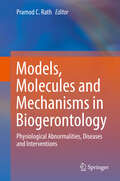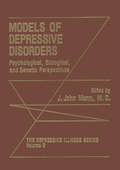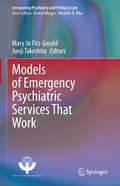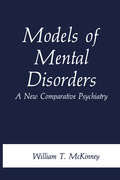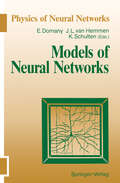- Table View
- List View
Models in Environmental Research (GKSS School of Environmental Research)
by Götz Flöser HansStorchIn most natural sciences, modeling is a widespread method of gaining new knowledge about natural and technical systems. This book analyses the concepts of 'model' and 'modeling' in different fields of research. The different methods of modeling as well as the potentials and limits of this concept are reflected and discussed. The book presents a variety of modeling techniques, from mathematical models in climatology, meteorology or oceanography to methods used in morphology, decision-making in ecology and physical modeling in oceanography. In this broad overview regarding modeling, the book is unique.
Models, Molecules and Mechanisms in Biogerontology: Cellular Processes, Metabolism and Diseases
by Pramod C. RathThe book deals with basic cellular and molecular mechanisms associated with aging. It comprehensively describes the important genetic, epigenetic, biochemical and metabolic regulations during aging, as well as some important age-related diseases.The book is divided into four major sections for easy understanding. It takes the readers through the various aspects of aging in a story-like manner. Certain interventions for healthy aging such as dietary restriction, regular exercise and maintaining a balanced and peaceful life-style are also suggested by the experts. The book would be a companion for both beginners, as well as established researchers in the field. It would be useful for science education, research, clinical approach and policy making.
Models, Molecules and Mechanisms in Biogerontology: Physiological Abnormalities, Diseases and Interventions
by Pramod C. RathThis book examines the basic cellular and molecular mechanisms associated with aging. It comprehensively describes the genetic, epigenetic, biochemical and metabolic regulation of aging, as well as some important age-related diseases. Divided into two major sections, it takes readers through the various aspects of aging in a story-like manner and suggests various interventions for healthy aging, such as dietary restriction, regular exercise, nutrition and maintaining a balanced and a non-stressful lifestyle. It describes the implications of aging on the nervous system, metabolism, immunity and stem cells as well as care for the elderly. The book is an ideal companion for both new and established researchers in the field and is also useful for educators, clinicians and policy makers.
Models of Anaerobic Infection: Proceedings of the third Anaerobe Discussion Group Symposium held at Churchill College, University of Cambridge, July 30-31, 1983, followed by the abstracts of the first meeting of the Society for Intestinal Microbial Ecology and Disease, Boston, November 1983 (New Perspectives in Clinical Microbiology #10)
by M. J. HillThe ADG held its first International Symposium at Churchill College, Cambridge, in July 1979. The second symposium was also held at Churchill College on 30-31 July, 1981, and this, the third, took place at the same college on 30-31 July,. 1983. The meeting was structured in a format which we hoped would appeal to the full range of our membership. The philosophy of the ADG is that medical microbiologists, veterinarians, toxicologists and dental bacteriologists have much to learn from each other and can best be achieved by bringing these various disciplines together frequently and in informal surroundings. Again the symposium was very generously sponsored by May and Baker Limited who met all costs of the meeting and entertained us splendidly. David Jackson and Donald Bedford were re sponsible for coordinating with the ADG on behalf of May and Baker and, as usual, gave us their full cooperation. This book contains the full-length papers, followed by the posters presented at the meeting. This book also serves as a vehicle for the abstracts of the first meeting of the Society for Intestinal Microbial Ecology and Disease, SIMED, held in Boston, Massachusetts. An introduction to this new society by its President, Sydney M. Finegold, M.D., precedes the abstracts. M.J. Hill VI CONTENTS Preface v List of contributors VIII Introduction to the Anaerobe Discussion Group M.J. Hill XI A guinea-pig model demonstrating synergy between Escherichia coli and Bacteroides fragilis in infected surgical wounds.
Models of Calcium Signalling: Mathematical Modeling Of Calcium Dynamics And Signal Transduction (Interdisciplinary Applied Mathematics #43)
by Geneviève Dupont Martin Falcke Vivien Kirk James SneydThis book discusses the ways in which mathematical, computational, and modelling methods can be used to help understand the dynamics of intracellular calcium. The concentration of free intracellular calcium is vital for controlling a wide range of cellular processes, and is thus of great physiological importance. However, because of the complex ways in which the calcium concentration varies, it is also of great mathematical interest.This book presents the general modelling theory as well as a large number of specific case examples, to show how mathematical modelling can interact with experimental approaches, in an interdisciplinary and multifaceted approach to the study of an important physiological control mechanism.Geneviève Dupont is FNRS Research Director at the Unit of Theoretical Chronobiology of the Université Libre de Bruxelles; Martin Falcke is head of the Mathematical Cell Physiology group at the Max Delbrück Center for Molecular Medicine, Berlin; Vivien Kirk is an Associate Professor in the Department of Mathematics at the University of Auckland, New Zealand; James Sneyd is a Professor in the Department of Mathematics at The University of Auckland, New Zealand.
Models of Depressive Disorders: Psychological, Biological, and Genetic Perspectives (The Depressive Illness Series #2)
by J. John MannThis volume is the second in a series on depressive illness. The first volume, entitled Phenomenology of Depressive Illness, is de voted to a description of depressive illness from many vantage points including that of the patient as well as the psychiatrist. Epidemiological, nosological, and developmental aspects are included together with specific descriptions of major subtypes of depressive illness. It is only after an illness is fully described that an attempt should be made to generate models with ex planatory and predictive properties. This second volume is that next step. The major models of depressive illness are described. The limited progress that has been made in integrating these models is discussed, but with further knowledge, this will change. Each model has different advantages and may apply more directly to different subtypes of depressive illness. Such refinements also await the results of future studies. However, the heuristic and clinical usefulness of the models described is considerable and will inform the reader about the current state of knowledge regarding the etiology and pathogenesis of de pressive illness and directions of future research. J. John Mann, M.D. New York vii ACKNOWLEDGMENTS This volume would not have been possible without the support of my wife and children who permitted me the time to work on it. Ms. Renee Azima-Heller assisted greatly in the organi zation of the material for the book. A career scientist award from the Irma T. HirschI Trust provided support for this work.
Models of Emergency Psychiatric Services That Work (Integrating Psychiatry and Primary Care)
by Mary Jo Fitz-Gerald Junji TakeshitaThis book describes a spectrum of possible solutions to providing comprehensive emergency psychiatric care. It discusses in detail all components of emergency psychiatric care, such as triage, security, management of suicide risk, violent patients, interdisciplinary treatment teams, administration, and telepsychiatry. It has been written by and is of interest to psychiatrists, emergency medicine physicians, nurses, social workers, administrators, the police and security staff.
Models of Horizontal Eye Movements: Part 4, A Multiscale Neuron and Muscle Fiber-Based Linear Saccade Model (Synthesis Lectures on Biomedical Engineering)
by Alireza Ghahari John D. EnderleThere are five different types of eye movements: saccades, smooth pursuit, vestibular ocular eye movements, optokinetic eye movements, and vergence eye movements. The purpose of this book series is focused primarily on mathematical models of the horizontal saccadic eye movement system and the smooth pursuit system, rather than on how visual information is processed. In Part 1, early models of saccades and smooth pursuit are presented. A number of oculomotor plant models are described here beginning with the Westheimer model published in 1954, and up through our 1995 model involving a 4th order oculomotor plant model. In Part 2, a 2009 version of a state-of-the-art model is presented for horizontal saccades that is 3rd-order and linear, and controlled by a physiologically based time-optimal neural network. Part 3 describes a model of the saccade system, focusing on the neural network. It presents a neural network model of biophysical neurons in the midbrain for controlling oculomotor muscles during horizontal human saccades. In this book, a multiscale model of the saccade system is presented, focusing on a multiscale neural network and muscle fiber model. Chapter 1 presents a comprehensive model for the control of horizontal saccades using a muscle fiber model for the lateral and medial rectus muscles. The importance of this model is that each muscle fiber has a separate neural input. This model is robust and accounts for the neural activity for both large and small saccades. The muscle fiber model consists of serial sequences of muscle fibers in parallel with other serial sequences of muscle fibers. Each muscle fiber is described by a parallel combination of a linear length tension element, viscous element, and active-state tension generator. Chapter 2 presents a biophysically realistic neural network model in the midbrain to drive a muscle fiber oculomotor plant during horizontal monkey saccades. Neural circuitry, including omnipause neuron, premotor excitatory and inhibitory burst neurons, long lead burst neuron, tonic neuron, interneuron, abducens nucleus, and oculomotor nucleus, is developed to examine saccade dynamics. The time-optimal control mechanism demonstrates how the neural commands are encoded in the downstream saccadic pathway by realization of agonist and antagonist controller models. Consequently, each agonist muscle fiber is stimulated by an agonist neuron, while an antagonist muscle fiber is unstimulated by a pause and step from the antagonist neuron. It is concluded that the neural network is constrained by a minimum duration of the agonist pulse, and that the most dominant factor in determining the saccade magnitude is the number of active neurons for the small saccades. For the large saccades, however, the duration of agonist burst firing significantly affects the control of saccades. The proposed saccadic circuitry establishes a complete model of saccade generation since it not only includes the neural circuits at both the premotor and motor stages of the saccade generator, but it also uses a time-optimal controller to yield the desired saccade magnitude. Table of Contents: Acknowledgments / A New Linear Muscle Fiber Model for Neural Control of Saccades\footnotemark / A Physiological Neural Controller of a Muscle Fiber Oculomotor Plant in Horizontal Monkey Saccades\footnotemark / References / Authors' Biographies
Models of Horizontal Eye Movements: Part 3, A Neuron and Muscle Based Linear Saccade Model (Synthesis Lectures on Biomedical Engineering)
by Alireza Ghahari John D. EnderleThere are five different types of eye movements: saccades, smooth pursuit, vestibular ocular eye movements, optokinetic eye movements, and vergence eye movements. The purpose of this book series is focused primarily on mathematical models of the horizontal saccadic eye movement system and the smooth pursuit system, rather than on how visual information is processed. A saccade is a fast eye movement used to acquire a target by placing the image of the target on the fovea. Smooth pursuit is a slow eye movement used to track a target as it moves by keeping the target on the fovea. The vestibular ocular movement is used to keep the eyes on a target during brief head movements. The optokinetic eye movement is a combination of saccadic and slow eye movements that keeps a full-field image stable on the retina during sustained head rotation. Each of these movements is a conjugate eye movement, that is, movements of both eyes together driven by a common neural source. A vergence movement is a non-conjugate eye movement allowing the eyes to track targets as they come closer or farther away. In Part 1, early models of saccades and smooth pursuit are presented. A number of oculomotor plant models are described therein beginning with the Westheimer model published in 1954, and up through our 1995 model involving a 4th-order oculomotor plant model. In Part 2, a 2009 version of a state-of-the-art model is presented for horizontal saccades that is 3rd-order and linear, and controlled by a physiologically based time-optimal neural network. In this book, a multiscale model of the saccade system is presented, focusing on the neural network. Chapter 1 summarizes a whole muscle model of the oculomotor plant based on the 2009 3rd-order and linear, and controlled by a physiologically based time-optimal neural network. Chapter 2 presents a neural network model of biophysical neurons in the midbrain for controlling oculomotor muscles during horizontal human saccades. To investigate horizontal saccade dynamics, a neural circuitry, including omnipause neuron, premotor excitatory and inhibitory burst neurons, long lead burst neuron, tonic neuron, interneuron, abducens nucleus, and oculomotor nucleus, is developed. A generic neuron model serves as the basis to match the characteristics of each type of neuron in the neural network. We wish to express our thanks to William Pruehsner for drawing many of the illustrations in this book. Table of Contents: Acknowledgments / 2009 Linear Homeomorphic Saccadic Eye Movement Model / A Neuron-Based Time-Optimal Controller of Horizontal Saccadic Eye Movements and Glissades / References / Authors' Biographies
Models of Horizontal Eye Movements, Part I: Early Models of Saccades and Smooth Pursuit (Synthesis Lectures on Biomedical Engineering)
by John EnderleThere are five different types of eye movements: saccades, smooth pursuit, vestibular ocular eye movements, optokinetic eye movements, and vergence eye movements. The purpose of this book is focused primarily on mathematical models of the horizontal saccadic eye movement system and the smooth pursuit system, rather than on how visual information is processed. A saccade is a fast eye movement used to acquire a target by placing the image of the target on the fovea. Smooth pursuit is a slow eye movement used to track a target as it moves by keeping the target on the fovea. The vestibular ocular movement is used to keep the eyes on a target during brief head movements. The optokinetic eye movement is a combination of saccadic and slow eye movements that keeps a full-field image stable on the retina during sustained head rotation. Each of these movements is a conjugate eye movement, that is, movements of both eyes together driven by a common neural source. A vergence movement is a non-conjugate eye movement allowing the eyes to track targets as they come closer or farther away. In this book, early models of saccades and smooth pursuit are presented. The smooth pursuit system allows tracking of a slow moving target to maintain its position on the fovea. Models of the smooth pursuit have been developed using systems control theory, all involving a negative feedback control system that includes a time delay, controller and plant in the forward loop, with unity feedback. The oculomotor plant and saccade generator are the basic elements of the saccadic system. The oculomotor plant consists of three muscle pairs and the eyeball. A number of oculomotor plant models are described here beginning with the Westheimer model published in 1954, and up through our 1995 model involving a 4$^{th}$ order oculomotor plant model. The work presented here is not an exhaustive coverage of the field, but focused on the interests of the author. In Part II, a state-of-art model of the saccade system is presented, including a neural network that controls the system. Table of Contents: Introduction / Smooth Pursuit Models / Early Models of the Horizontal Saccadic Eye Movement System / Velocity and Acceleration Estimation / 1995 Linear Homeomorphic Saccadic Eye Movement Model
Models of Horizontal Eye Movements, Part II: A 3rd Order Linear Saccade Model (Synthesis Lectures on Biomedical Engineering)
by John Enderle Wei ZhouThere are five different types of eye movements: saccades, smooth pursuit, vestibular ocular eye movements, optokinetic eye movements, and vergence eye movements. The purpose of this book is focused primarily on mathematical models of the horizontal saccadic eye movement system and the smooth pursuit system, rather than on how visual information is processed. A saccade is a fast eye movement used to acquire a target by placing the image of the target on the fovea. Smooth pursuit is a slow eye movement used to track a target as it moves by keeping the target on the fovea. The vestibular ocular movement is used to keep the eyes on a target during brief head movements. The optokinetic eye movement is a combination of saccadic and slow eye movements that keeps a full-field image stable on the retina during sustained head rotation. Each of these movements is a conjugate eye movement, that is, movements of both eyes together driven by a common neural source. A vergence movement is a non-conjugate eye movement allowing the eyes to track targets as they come closer or farther away. In this book, a 2009 version of a state-of-the-art model is presented for horizontal saccades that is 3rd-order and linear, and controlled by a physiologically based time-optimal neural network. The oculomotor plant and saccade generator are the basic elements of the saccadic system. The control of saccades is initiated by the superior colliculus and terminated by the cerebellar fastigial nucleus, and involves a complex neural circuit in the mid brain. This book is the second part of a book series on models of horizontal eye movements. Table of Contents: 2009 Linear Homeomorphic Saccadic Eye Movement Model and Post-Saccade Behavior: Dynamic and Glissadic Overshoot / Neural Network for the Saccade Controller
Models of Lung Disease: Microscopy and Structural Methods
by Joan GilThis research-level reference provides a review of the morphological techniques that have become a primary method of anatomical study correlating structure and function in lung physiology and pathology. Detailing the evolution of anatomy as a research discipline, it explores general structural techn
Models of Lung Disease: Microscopy and Structural Methods (Lung Biology In Health And Disease Ser. #47)
by Joan GilThis research-level reference provides a review of the morphological techniques that have become a primary method of anatomical study correlating structure and function in lung physiology and pathology. Detailing the evolution of anatomy as a research discipline, it explores general structural techn
Models of Mental Disorders: A New Comparative Psychiatry
by William T. McKinney Jr.My ideas for this book have been evolving over the last several years as I have been working in the animal modeling area and have seen it change rather dramatically. There have been tremendous advances, both in methodology and in conceptualization, yet the literature is scattered in journals encompassing many disciplines. In particular, there have been only very limited attempts to write about the philosophical, conceptual, and controversial issues in this field; to pull together diverse findings; and to provide some general perspective on its future. As will probably be apparent, I am a clinical psychiatrist who also has a fundamental interest in animal behavior, especially primate social behavior. I entered the field from a clinical research standpoint to devel op some animal models of depression after being stimulated to do so by Dr. William Bunney, then at the National Institute of Mental Health and now at the University of California-Irvine. The field has grown rapidly since then and there is considerable research activity. Indeed, the re search activity has grown more rapidly than our conceptualization of what animal models are and are not. Animal preparations are now available for studying specific aspects of certain types of psychopathology. Thoughtful workers in the animal modeling field no longer talk about comprehensive models but rather about more limited experimental preparations in animals for studying certain specific aspects of human psychopathology.
Models of Neural Networks (Physics of Neural Networks)
by Eytan Domany J. Leo Van Hemmen Klaus SchultenOne of the great inteJlectual cha1lenges for the next few decades is the question of brain organization. What is the basic mechanism for storage of memory? What are the processes that serve as the interphase between the basically chemical processes of the body and the very specific and nonstatistical operations in the brain? Above all. how is concept formation achieved in the human brain? I wonder whether the spirit of the physics that will be involved in these studies will not be akin to that which moved the founders of the ''rational foundation of thermodynamics". CN. Yangl 10 The human brain is said 10 have roughly 10 neurons connected through about 14 10 synapses. Each neuron is itself a complex device which compares and integrates incoming electrical signals and relays a nonlinear response to other neurons. The brain certainly exceeds in complexity any system which physicists have studied in the past. Nevertheless, there do exist many analogies of the We have witnessed during the last decade brain to simpler physical systems.
Models of Neural Networks I (Physics of Neural Networks)
by Eytan Domany J. Leo Van Hemmen Klaus SchultenOne of the great intellectual challenges for the next few decades is the question of brain organization. What is the basic mechanism for storage of memory? What are the processes that serve as the interphase between the basically chemical processes of the body and the very specific and nonstatistical operations in the brain? Above all, how is concept formation achieved in the human brain? I wonder whether the spirit of the physics that will be involved in these studies will not be akin to that which moved the founders of the "rational foundation of thermodynamics". C. N. Yang! 10 The human brain is said to have roughly 10 neurons connected through about 14 10 synapses. Each neuron is itself a complex device which compares and integrates incoming electrical signals and relays a nonlinear response to other neurons. The brain certainly exceeds in complexity any system which physicists have studied in the past. Nevertheless, there do exist many analogies of the brain to simpler physical systems. We have witnessed during the last decade some surprising contributions of physics to the study of the brain. The most significant parallel between biological brains and many physical systems is that both are made of many tightly interacting components.
Models of Seizures and Epilepsy
by Asla Pitkänen, Philip A. Schwartzkroin, Solomon L. MoshéAn understanding of mechanisms underlying seizure disorders depends critically on the insights provided by model systems. In particular with the development of cellular, molecular, and genetic investigative tools, there has been an explosion of basic epilepsy research. Models of Seizures and Epilepsy brings together, for the first time in 30 years, an overview of the most widely-used models of seizures and epilepsy. Chapters cover a broad range of experimental approaches (from in vitro to whole animal preparations), a variety of epileptiform phenomenology (including burst discharges and seizures), and suggestions for model characterization and validation, such as electrographic, morphologic, pharmacologic, and behavioral features. Experts in the field provide not only technical reviews of these models but also conceptual critiques - commenting on the strengths and limitations of these models, their relationship to clinical phenomenology, and their value in developing a better understanding and treatments. Models of Seizures and Epilepsy is a valuable, practical reference for investigators who are searching for the most appropriate laboratory models for addressing key questions in the field. It also provides an important background for physicians, fellows, and students, offering insight into the potential for advances in epilepsy research. - The first comprehensive description of animal models of epilepsy since the early 1970's - Comprehensive analysis of "What the models model" to guide the selection of each model, and what specific questions it will answer - Elegant examples of the use of novel technologies that can be applied in experimental epilepsy research - World expert opinions on the clinical relevance of each model
Models of Seizures and Epilepsy
by Asla Pitkänen Paul S. Buckmaster Aristea S. Galanopoulou Solomon L. MoshéModels of Seizures and Epilepsy, Second Edition, is a valuable, practical reference for investigators who are searching for the most appropriate laboratory models to address key questions in the field. The book also provides an important background for physicians, fellows, and students, offering insight into the potential for advances in epilepsy research as well as R&D drug development. Contents include the current spectrum of models available to model different epilepsy syndromes, epilepsy in transgenic animals, comorbidities in models of epilepsy, and novel technologies to study seizures and epilepsies in animals. - Provides a comprehensive reference detailing animal models of epilepsy and seizure - Offers insights on the use of novel technologies that can be applied in experimental epilepsy research - Edited by leading experts in the field that provide not only technical reviews of these models but also conceptual critiques - Comments on the strengths and limitations of various models, including their relationship to clinical phenomenology and their value in developing better understanding and treatments
Models of the Visual System (Topics in Biomedical Engineering)
by George K. Hung Kenneth C. CiuffredaSome of the best vision scientists in the world in their respective fields have contributed to chapters in this book. They have expertise in a wide variety of fields, including bioengineering, basic and clinical visual science, medicine, neurophysiology, optometry, and psychology. Their combined efforts have resulted in a high quality book that covers modeling and quantitative analysis of optical, neurosensory, oculomotor, perceptual and clinical systems. It includes only those techniques and models that have such fundamentally strong physiological, control system, and perceptual bases that they will serve as foundations for models and analysis techniques in the future. The book is aimed first towards seniors and beginning graduate students in biomedical engineering, neurophysiology, optometry, and psychology, who will gain a broad understanding of quantitative analysis of the visual system. In addition, it has sufficient depth in each area to be useful as an updated reference and tutorial for graduate and post-doctoral students, as well as general vision scientists.
Models of Wave Memory (Lecture Notes in Morphogenesis)
by Serguey KashchenkoThis monograph examines in detail models of neural systems described by delay-differential equations. Each element of the medium (neuron) is an oscillator that generates, in standalone mode, short impulses also known as spikes. The book discusses models of synaptic interaction between neurons, which lead to complex oscillatory modes in the system. In addition, it presents a solution to the problem of choosing the parameters of interaction in order to obtain attractors with predetermined structure. These attractors are represented as images encoded in the form of autowaves (wave memory). The target audience primarily comprises researchers and experts in the field, but it will also be beneficial for graduate students.
Moderate Procedural Sedation and Analgesia: A Question and Answer Approach
by Michael KostIntroducing the definitive resource designed for practitioners working in the rapidly expanding area of moderate procedural sedation and analgesia clinical practice. Moderate Procedural Sedation and Analgesia: A Question and Answer Approach focuses on the preprocedural, procedural, and postprocedural care of the moderately sedated patient in a variety of settings. This comprehensive text is designed to provide all the content and tools nurses and other clinicians need to demonstrate competency in moderate sedation and analgesia. Additionally, this user-friendly text is written by well-known sedation/analgesia expert, Michael Kost and recommended by standards of practice from the ANA, AORN, and the American Academy of Pediatrics. - New clinically focused text ensures clinicians involved in the administration and management of patients receiving moderate sedation have access to the most up-to-date information. - Strong safety focus throughout the book explains how technology and clinician practice can improve sedation administration. - Chapters organized in clinical problem/question plus answer format help you easily comprehend material. - Follows the latest TJC Sedation/Anesthesia Guidelines ensuring you are ready for medication administration in clinical practice. - Pediatrics and Geriatrics chapters cover specific sedation practice recommendations that address the substantive clinical practice challenges associated with these patient populations. - Pharmacologic profiles of medications detail their use in the moderate sedation practice setting.
Moderate Sedation and Emergency Medicine for Periodontists
by Joseph A. Giovannitti Jr.This book is intended for periodontal residents and practicing periodontists who wish to incorporate the principles of moderate sedation into daily practice. A history of the development of sedation in dental practice sets the stage for understanding the need for a comprehensive preanesthetic evaluation to identify potentially reactive patients prior to treatment. Useful drugs for moderate sedation and reversal agents in the office setting are reviewed to ensure proper perioperative usage. Comprehensive airway management and rescue skills are then documented in detail so that the patient may be properly managed in the event that the sedation progresses beyond the intended level. A key aim is to equip the reader with sufficient knowledge and preparedness to overcome the patient management challenges associated with common and uncommon deviations from intraoperative norms. Finally, for those academicians interested in teaching the principles of sedation to periodontal residents, a curriculum development tool is provided to ensure comprehensive training leading to competency.
Moderate to Severe Psoriasis
by John Y. M. Koo Ethan C. Levin Argentina Leon Jashin J. Wu Alice B. GottliebWritten by experts in the dermatology field, this new fourth edition of Moderate-to-Severe Psoriasis discusses the current use of biologics and other pharmacologic and phototherapy treatments for moderate-to-severe psoriasis. Illustrated with high quality color figures, this standalone text emphasizes safe and effective treatments for the psoriasis
Moderate to Severe Psoriasis
by John Y. M. Koo Ethan C. Levin Argentina Leon Jashin J. Wu Alice B. GottliebWritten by experts in the dermatology field, this new fourth edition of Moderate-to-Severe Psoriasis discusses the current use of biologics and other pharmacologic and phototherapy treatments for moderate-to-severe psoriasis. Illustrated with high quality color figures, this standalone text emphasizes safe and effective treatments for the psoriasis
Modern Adaptive Randomized Clinical Trials: Statistical and Practical Aspects
by Oleksandr SverdlovIs adaptive randomization always better than traditional fixed-schedule randomization? Which procedures should be used and under which circumstances? What special considerations are required for adaptive randomized trials? What kind of statistical inference should be used to achieve valid and unbiased treatment comparisons following adaptive random


